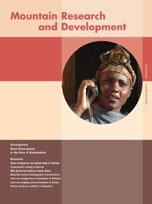Shifting Cultivation and Sustainable Development of North-Eastern India: Tradition in Transition, edited by P.S. Ramakrishnan, K.G. Saxena, and K.S. Rao. New Delhi, India: Oxford and IBH Publishing Co. Pvt. Ltd., 2006. xxviii + 495 pp. Rs 950. ISBN 81-204-1625-2.
Edited volumes are often difficult to review, as they comprise chapters by different authors who, no matter how thorough the editors' oversight, are unlikely to achieve the coherence of a single writer; and the larger the book, the more difficult. So at 495 pages and 29 contributors, I expected Shifting Cultivation and Sustainable Development of North-Eastern India to be a challenge. It is invidious to select for comment 3 or 4 chapters from several—in the case of this volume 20—probably on no other grounds than that they discuss issues of particular interest to the reviewer. I know how irritating it is to be one of the omitted contributors. Yet to attempt a comprehensive review, particularly of a book this size, invariably means a glancing engagement with the issues.
The volume's tight focus on Arunachal Pradesh and the topic of shifting agriculture, locally called jhum, make the task more manageable. The fact that the first-named editor is the single author of 5 chapters, accounting for about one-third of the entire book, lends further coherence, stamping the volume with his view of issues central to shifting cultivation and sustainable development of northeastern India—fields to which he has made notable contributions over many years. The topics include land-use and vegetation-cover changes in the North-Eastern Hills; the need for an agroecosystems analysis of jhum, along with what he calls a socioecological system view of the landscape; research into the patterns and processes of forest fallow secondary successions; and the need to view village ecosystems within their landscapes, which, he thinks, offers a way of seeing farming integrated with forest.
The book is helpfully divided into 6 sections, partly by region and partly by topic. These deal with land-use and land-cover changes in the North-Eastern Hills; a review of current knowledge regarding the region's landscape under jhum farming; various issues relating to Namdapha National Park in Arunachal Pradesh; the situation in the West Kameng and Tawang regions of Arunachal Pradesh; comparative issues in other mountain regions of India; and, finally, a section entitled “Reconstructing the fractured cultural landscape.”
The section on Namdapha National Park opens with a discussion of land-use and vegetation changes in the Park. It includes several chapters dealing with biodiversity conservation based on protected areas, on the one hand, and a field station at Chessa that undertakes botanical-garden-like ex situ conservation, on the other. A particularly interesting chapter discusses ethnobotany in the Park's buffer zone. The other theme in this section is agriculture, with a chapter discussing Chakma cultivation practices from an ecosystems perspective and another dealing with socioeconomic issues related to the exploitation of secondary forest by communities living around the Park.
The section on the West Kameng and Tawang regions begins with a discussion of land tenure and the upland jhum farming regime. Other chapters discuss the role of livestock in the local farming regime, the involvement of local communities in forest management, and the role of non-timber forest products in rural livelihoods. The section on other mountain regions includes chapters on shifting cultivation in the Central and Eastern Himalayas from a landscape ecology perspective; integrated natural resource management and socioeconomic issues in the Sikkim Himalayas; and land-use change, conservation, and related natural resource management issues in the Western Ghats of Kerala.
The concluding section opens with a chapter by the volume's senior editor where he attempts to pull together the various chapters using the concept of “cultural landscape,” which, he claims, is an emerging paradigm integrating ecology, economics, and culture to address development and conservation issues. The final chapter is a brief discussion about communicating the scientific view of development issues to “stakeholders.”
The volume includes some valuable ethnographic and ecological data and discussion of issues relating to development and conservation in the North-Eastern Hills region of India. It is excellent, so far as it goes. As noted above, achieving an integrated edited volume is no easy task; some of the chapters in this book perhaps have too much the air of project reports submitted to the agency funding the research: UNESCO New Delhi under the Man and the Biosphere Programme with support from the MacArthur Foundation. This signals, in some senses, a missed opportunity.
A symptom of the report-like structure is the fact that, while this volume addresses in admirable detail issues relating to both the environmental and cultural dimensions of shifting cultivation, as well as related problems of development and conservation in Arunachal Pradesh, it misses the opportunity to situate these in the context of discussions of similar farming regimes and associated issues in other parts of the world. There are comprehensive studies of shifting cultivation from Latin America, Africa, New Guinea, and Indonesia that might help to throw a novel comparable light on the problems and issues in Arunachal Pradesh. We know that this way of farming is not necessarily as environmentally degrading as some assume, particularly those working in development, and that under appropriate conditions it is not only sustainable but an integral part of the natural environments that we see today and that have been subject to generations of human interference and management. Another symptom of the book's narrow focus is that it addresses issues relating to development and conservation almost in a vacuum, disregarding the fact that there is now a vast literature on participation in development, local (indigenous) knowledge and community involvement in conservation schemes that could usefully inform and deepen discussion.
In conclusion, this book will prove a valuable resource to those who wish to know more about jhum shifting cultivation in northeastern India, both its cultural and ecological aspects, and issues relating to development and conservation.





